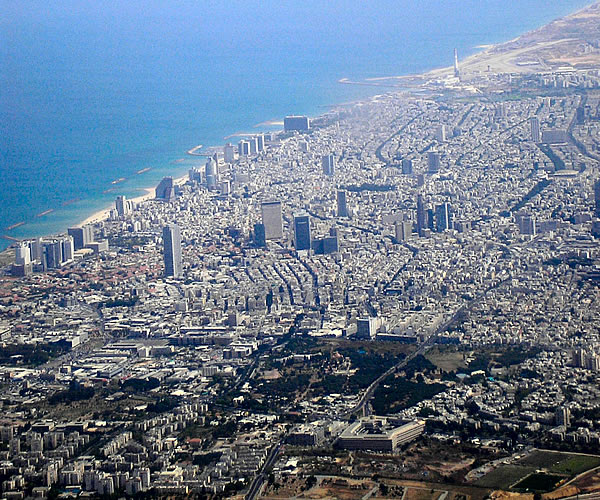
The distinctive religion and culture of the Jewish people began to emerge in the region of what is now Israel some 4000 years ago. The idea of a homeland for the Jewish people and of a “return to Zion” has existed for centuries: at Passover Jews turn towards Jerusalem when they pray and recite the words “next year in Jerusalem”. The Hebrew language, the Torah (the Jewish holy book), the Jewish laws of the Talmud, the Jewish calendar and Jewish holidays and festivals all originated in Israel and revolve around its seasons and conditions. However it was not until the late 19th century, when the rise of anti-Semitism led to a resurgence of pogroms in Russia and Eastern Europe, that European Jews began immigrating to what was then known as Palestine and the Zionist movement began in earnest. At the same time a wave of Jews immigrated to Palestine from Yemen, Morocco, Iraq and Turkey. In 1897 Jewish leaders formally organized the Zionist political movement, calling for the restoration of the Jewish national homeland in Palestine, a place where Jews could both find sanctuary and obtain self-determination as a unified nation.
When the city of Tel Aviv (meaning “hill of spring”) came into being at the beginning of the 20th century it was under Turkish rule. In 1916 the Turks evacuated the city but the population was resettled there once Palestine became a British protectorate in 1917. Following riots in the neighbouring city of Jaffa in 1921 many Jews fled to Tel Aviv and by 1931 the city’s population had reached 45,000. Its population continued to grow during the 1930’s, reaching a level of 145,000 by 1941. After the end of World War II the British withdrew from Palestine and the UN partitioned the area into Arab and Jewish states, an arrangement rejected by the Arabs. The Jews of Palestine declared the creation of the modern state of Israel in 1948, with Tel Aviv as its capital. Over the next twenty years a series of military victories against Arab forces allowed Israel to extend its territory: Israel took over the city of Jerusalem in 1950, making it its new capital; further areas were occupied following the 1967 war. In 1982 Israel withdrew from the Sinai desert, which returned to Egypt, and outstanding territorial disputes with Jordan were resolved in the Israel-Jordan Treaty of Peace in 1994. The displacement and oppression of the non-Jewish Palestinian population since the creation of the state of Israel has been a constant source of tension in the region, with both military and civilian casualties on both sides. Tel Aviv was targeted by Iraqi Scud missiles during the first Gulf War and since the early 1990’s: Tel Aviv has been the target of Palestinian guerrillas and suicide-bombers that have launched attacks in public areas such as shopping malls, cafes and restaurants as well as on buses.
The Middle East enjoyed relative stability under Israeli Prime Minister Yitzhak Rabin (the first Israeli-born PM of Israel) following the signing of the Oslo Accords with Palestinian officials in 1993, which laid the foundations for the creation of an autonomous Palestinian state alongside Israel. The signing of the treaty was seen as a traitorous act by extreme right-wing movements in Israel and Rabin was assassinated in 1995 - the only Israeli prime minister to be assassinated while in office. In May 2000 Israel withdrew from southern Lebanon, which it had occupied as a “buffer zone” since 1982. In accordance with the Madrid Conference of October 1991 bilateral negotiations were conducted between Israel, the Palestinians and Syria to achieve a permanent settlement, to no avail. The world anticipated an end to the stalemate with the death of Palestinian leader Yasir Arafat in 2004, but despite the formulation of various “road maps” for peace by successive US presidents a lasting peace, with Israelis and Palestinians living side by side in their respective nations, has yet to be achieved.
For a taste of the old Tel Aviv you can take a walk down Rothschild Boulevard. This was the first main street in the city and the majority of the buildings are from the beginning of the twentieth century. On Fridays during the summer months there are colourful street parties there.
Update 4/07/2008
Keep more of your money when transferring funds overseas!

If you want to move money abroad, from Israel or to Israel for example, Fexco provides efficient and secure global bank to bank transfers and bespoke payment solutions for both business and personal clients.
Why Fexco
Fexco provides a secure international money transfer service online or by telephone with bank beating fx rates and low fees. Specialises in high-value transfers.
Main characteristics
Fexco will help you to keep your overseas money transfer costs to a minimum.
| Margin | 0.6% |
|---|---|
| Regulator | FCA |
| Fee | £10 < £5K or Free > £5k |
| Mini | £1K |
| Ccy | All (130 currencies, incl ‘exotics’) |
| Services | Repatriation of funds, Property, Regular payments, High Value payments, spot, online, telephone. |
Get an online quote today
When you are ready to make your transfer, John and his team will be available to help you with better rates and an unrivalled service to make sure your funds are delivered securely and speedily.
